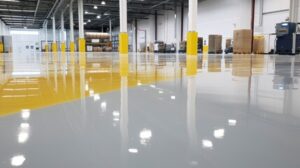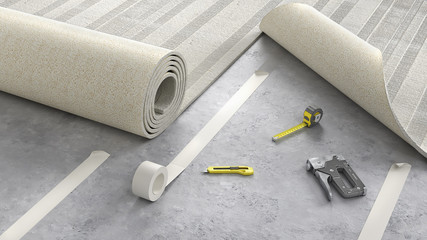Epoxy Flooring Huntsville TX is a durable and attractive solution for any commercial or industrial space. Unlike tile floors, epoxy coatings create an impenetrable, non-porous surface that’s highly resistant to spills and flooding.

This means less cleanup and upkeep, saving money over the long term. Plus, slip-resistant options are available for added safety.
Epoxy floors are renowned for their durability. They can withstand a lot of weight without being damaged, and they can be used in environments that would typically damage standard flooring solutions. They also have excellent chemical and stain resistance, which can make them easier to clean than most other floor coatings. These properties can help to reduce the frequency and cost of cleaning, which can save money and labour.
When correctly installed and maintained, epoxy floors can last a long time in harsh industrial environments. However, the lifespan of an epoxy floor can be affected by poor maintenance practices. For example, a well-maintained epoxy floor will be free of dirt and debris, and will undergo scheduled maintenance tasks like resealing when necessary. This will increase the longevity of the floor. Conversely, a poorly maintained floor will be subject to dirt and debris accumulation, which can cause the epoxy to deteriorate faster than it should.
For those with epoxy floors at home or in business, the best way to care for them is to regularly sweep and vacuum the surface. This helps to keep the floor free of dirt, which can scratch and damage the surface. A standard dust mop should be adequate for this purpose, although a soft push broom is recommended if your floors have an anti-slip texture.
Additionally, spills should be cleaned promptly to minimise the impact on the coating. This will help to prevent the growth of mould, and may even avoid a costly repair bill. Finally, it is recommended that you use protective pads or entry rugs in areas where heavy machinery and vehicles will be parked to mitigate floor scratches and damage.
Epoxy floors can be customised with the addition of slip-resistant aggregate. This helps to ensure that the surface is safe for people to walk on, and is especially important in wet or slippery conditions. It is also possible to add coloured acrylic flakes to the epoxy to improve aesthetics. Adding these flakes can create a more vibrant and appealing floor that can enhance the look of any environment.
Easy to Clean
As long as you use common sense in caring for your epoxy flooring, it is very easy to maintain. It is best to sweep the floor on a regular basis in order to remove any dirt or sand that might be embedded in the coating. This will help prevent scratches from being formed to the floor and it can also reduce wear to the surface. This is especially important if you have heavy machinery or vehicles that are being driven over the floors regularly.
It is a good idea to wipe up any spills immediately, particularly if they contain chemicals or oil. If these liquids are allowed to sit on the floor for too long they can damage the epoxy coating. This is especially true of antifreeze and engine oil, which have chemicals that are abrasive to the floor surface. You should also wipe up any paint or household cleaners that are spilled on the floor right away, and any other abrasive liquids like gasoline.
To mop your epoxy floor, you should use a microfiber mop which is gentle on the floor and highly absorbent. Dip the mop into a cleaning solution and wring it out to get rid of any excess water. Then mop the floor using a systematic pattern, overlapping areas as you go. This will ensure that all parts of the floor are cleaned thoroughly.
You should never use abrasive scrub pads or harsh cleaning chemicals on your epoxy floor. This can cause the epoxy coating to become damaged and scratched, which will result in it being more difficult to clean. If you do need to scrub an area of the floor to remove a stain, it is best to start with a mild solution and move up to more powerful products if necessary. Rust stains, for example, can often be removed by using a kitchen sponge or pad and a soft scrubbing solution.
To help you keep your floor looking clean and new, it is a good idea to place a walk-off mat at the entrance to your garage or industrial facility. This will collect any grit or dirt that is tracked onto the floor and will help to reduce the amount of dust and debris that needs to be swept up. You should also try to avoid scratching your floors by placing plywood or mats under any jacks, vehicles, or heavy equipment that you might be using.
Slip-Resistant
Slipping accidents are a major safety issue in commercial and industrial spaces, resulting in costly workers’ compensation claims. Fortunately, epoxy floors provide effective solutions for mitigating these risks and protecting employees from injury and lawsuits.
Slip-resistant epoxy floor coatings are available in a variety of texturing options that are ideal for high-traffic areas, such as those with heavy machinery or vehicles. Silica sand (also called quartz sand) or a non-skid additive is used in the epoxy mix to create a rough, bumpy texture that increases gripping power and prevents slippage. The addition of the non-skid additive also allows the epoxy floor coating to withstand impacts and abrasions.
Another way to improve the slip resistance of an epoxy floor is by using a topical anti-slip sealer, which can be applied over cured epoxy flooring to offer additional safety. Additionally, regular cleaning is a key component of maintaining slip-resistant flooring. Sweeping or vacuuming the floor regularly helps to remove any loose dirt or debris that could affect traction, and mopping the floor with a mild detergent or epoxy-safe cleaner can help keep it looking great.
Prioritizing slip resistance is a great way to increase the durability and longevity of an epoxy floor, and it also demonstrates a commitment to employee safety. In addition, it can help to mitigate the financial impact of slipping accidents and damage caused by water or chemical spills.
If you’re considering an epoxy flooring system for your business or commercial space, talk to an industry expert about how you can incorporate anti-slip features into the floor’s design. The right contractor can assist with surface preparation and application techniques to ensure the highest level of slip resistance and long-term performance.
Epoxy flooring systems have numerous benefits, including durability, ease of cleaning and slip-resistance, making them a popular choice for both residential and commercial settings. However, many people are wary of these floors due to their perceived slippery nature, especially when wet. Fortunately, advances in epoxy formulations and application methods have greatly enhanced their slip resistance. This makes these floors an excellent option for those seeking a safe, attractive and functional surface.
Affordable
If you’re looking to spruce up a room, upgrade your garage or create an industrial floor, epoxy floors are a cost-effective option that looks great. They aren’t cheap, but they aren’t out of the reach of most people, either. If you shop around, you’ll find an installer who offers competitive pricing and is willing to work with you on customizing your flooring.
The price of an epoxy floor depends on the square footage and what your needs are. For example, a two-car garage will cost more than a one-car garage. The condition of the concrete will also affect your costs. It must be clean, dry and free of cracks and chips before applying the epoxy coating. Professional contractors use a power washer, caustic acid etching chemicals or sandblasting to prepare the concrete for the coating. The prep work can add up to $50 per square foot in addition to the cost of the epoxy itself.
Once the epoxy is applied, it will need to cure for a few days before you can use the floor. During that time, it is important to keep it out of the sunlight and away from dust or dirt. During this time, it is also a good idea to prohibit additional foot traffic, if possible.
After the curing process, you can sweep or mop your floor. This should be done on a daily basis to remove dust and other debris that can scratch the surface of the epoxy. Sweeping is best with a micro fibre mop and a soft bristled broom.
You can also add anti-slip grit to the final coat of epoxy or clear topcoat to prevent accidents. Grit options include sand, aluminum oxide and polymeric grit. The latter is the most effective and durable but also the most expensive option. You can add it to a single coat of epoxy or to the entire floor. The grit can be purchased at most hardware stores and home improvement centres. It can be installed in place of or beneath the epoxy, depending on your preference and budget.

